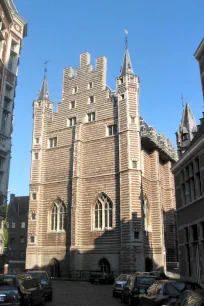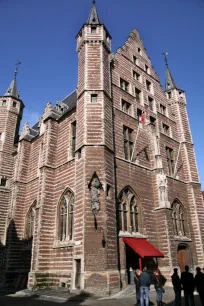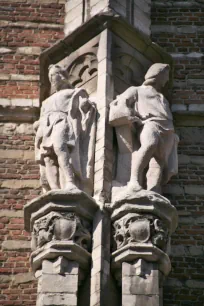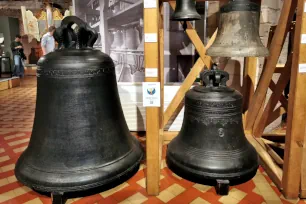The Vleeshuis is a five-hundred-year-old Gothic building not far from the city hall. Literally translated, Vleeshuis means ‘Meat House’, but it is better known as the Butchers’ Hall. It is one of the oldest surviving buildings in Antwerp.
The Butcher’s Hall is currently closed due to a thorough renovation that will expand the visitor’s area to all seven floors. It is expected to reopen in 2030.



Old Butchers’ Hall
A Butchers’ Hall was built here as early as in 1250. The building functioned as a meat market where butchers could sell their merchandise.
The beginning of the sixteenth century marked the start of Antwerp’s Golden Age, during which Antwerp became Europe’s third-largest city and its most important trade center. The existing Butchers’ Hall, at that time 250 years old, couldn’t cope with the growing population, so the expanding butchers’ guild decides to build a new Butchers’ Hall at the same spot but twice as large as the existing hall.
Construction of the new Butchers’ Hall
The butchers’ guild commissioned master builder Herman de Waghemakere to construct a functional building that would also reflect the growing status of their guild.
It is not clear, however, whether Herman de Waghemakere – who at the time was working on the nave of the cathedral – or his son Dominicus de Waghemakere – who built Antwerp’s stock market in 1515 – designed the new hall. Both architects employed the late Gothic style used for the Butchers’ Hall.
Construction of the new building started in 1501 and was completed in 1504. For its time, this was a very large civil building, 21 meters wide and 46 meters high. Its facade was made of red brick with layers of white sandstone (bacon layers as it is locally known). All four corners of the Butchers’ Hall feature a small round tower. A fifth, wider tower is set at the middle of the southern side. Not much is known about the original interior, but the building included at least a 624 sq. m. (6700 sq. ft) meat market and a chapel.
After the Guilds
The Butchers’ Hall lost its prime function in 1810 when the French occupying forces abolished the guilds. During the nineteenth century, the building was in use as a storage depot and a theater.
In 1899 the city acquired the Butchers’ Hall. After a restoration from 1901 to 1914 the building reopened as a museum in 1919. It displayed a heterogeneous collection of historic objects, including pottery, drawings, lace, weapons and jewelry.
City Sounds Museum

The Butchers’ Hall reopened in September of 2006 as the Museum Butchers’ Hall – Sounds of the City, a museum of that tells the story of 600 years of music in the city of Antwerp. More info can be found on its website, museumvleeshuis.be. The Butcher’s Hall closed again in 2024 to prepare for a thorough renovation of both the exterior and interior. The museum will expand significantly and visitors will be able to access all seven floors of the historic building when it reopens in 2030.
- Next: Handelsbeurs
- More Sights & Attractions in Antwerp

